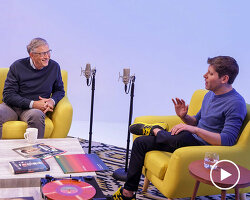PLAUD NOTE transcribes audio using ChatGPT
ChatGPT, an AI language model developed by OpenAI, has been integrated into a number of devices, electronics and even means of transport these days. If not yet embedded today, brands and companies are starting to play with the idea of installing the language model into their offerings, hoping to simplify the product experience for their users. The AI language model and tool is no longer at bay on smartphones and computers, answering written questions or carrying out instructions. It is being adopted into a broader tech use, further training it to, as its enthusiasts hope, alleviate users’ real-time needs.
Some of the brands and companies have already a clear idea in mind of how they are going to use ChatGPT. For instance, PLAUD NOTE employs the AI language model to transcribe meetings and audio recordings and installs it in an attachable one-press voice recorder. The startup describes its device as an advanced voice recording application and tool that can simplify audio documentation using ChatGPT and artificial intelligence. The ultra-slim, credit-card-sized recorder can fit and be plastered behind the majority of large-screened smartphones these days. It has a single-press function so the user, before a meeting or a call, can simply activate the device with one click rather than fumbling on their screen to find their recording app.
Before the user can start transcribing the audio in real-time, they have to download the dedicated app of PLAUD NOTE so the device and the app can be in sync. The design team says that their device’s AI algorithms provide ‘highly accurate transcriptions and summaries in various formats. By leveraging OpenAI Whisper’s advanced algorithms, PLAUD NOTE’s app transcribes recordings into precise, time-coded texts with human-level accuracy. This ensures reliable records of your important conversations and content, with minimal errors or omissions,’ PLAUD NOTE says. The device also churns out automated summaries in around five seconds and can create structured content such as meeting notes, mind maps, to-do lists, and diaries.

PLAUD NOTE can be attached to the back of the phone | image courtesy of PLAUD NOTE
using the AI language model with Mercedes-Benz
The potential of ChatGPT in becoming a spot-on transcriber may be closer to reality, given its ability to clean up word structures and even summarize research papers, rephrase lengthy texts, and simplify documents with jargon into layman’s terms. The AI language model and tool can also be at its user’s command, conveying its intellectual and high-tech butler services to them by following their vocal instructions. Mercedes-Benz hops on the ChatGPT wagon as it integrates it into its existing in-car voice control Azure OpenAI Service, leveraging the capabilities of Microsoft’s cloud and AI platform into its vehicles.
Mercedes-Benz MBUX Voice Assistant has already set a large command portfolio where the driver and passengers can receive sports and weather updates, have questions answered about their surroundings, or even control their smart homes. With ChatGPT entering, the AI tool is expected to blur the drawn limitations to predefined tasks and responses, improve natural language understanding, and expand the topics to which it can respond. Here, as Mercedes-Benz states, users will experience a voice assistant that not only accepts natural voice commands but can also conduct conversations.
Sooner or later, the driver and passengers can ask the ChatGPT-powered Voice Assistant for details about their destination, suggest a new dinner recipe, or answer a complex question. In return and depending on how the car brand will develop its algorithms and systems, the users will receive a more comprehensive answer while keeping their hands on the wheel and eyes on the road.

AI language model with Mercedes-Benz Voice Assistant | image courtesy of Mercedes-Benz
Urtopia fusion e-bike helps riders though chatGPT
Since ChatGPT is foreseen to have the ability to answer complex questions while on road, Urtopia’s decision to install it in their Fusion e-bike to help riders during their cycling may be considered an upside. The way Urtopia sees it, Fusion e-bike integrating ChatGPT in its system, alongside built-in speakers, can become the personal tour guide of the riders. They can ask questions to ChatGPT about what places they can visit during their sightseeing, information about the scenic spots, and the history of the monuments, among others. In a few seconds, the artificial intelligence-fueled language processing tool can give them facts and answers, verbally spoken and heard through the built-in speakers.
Urtopia Fusion, considered the world’s first e-bike with integrated ChatGPT, showcased additional exclusive features including built-in GPS navigation, anti-theft measures, riding safety enhancements, and data recording capabilities. By combining the capabilities of ChatGPT and Urtopia’s voice recognition system, the Urtopia Fusion smart e-bike may offer riders real-time assistance tailored to their requirements. It serves as a knowledgeable city guide and a riding encyclopedia, providing riders with personalized support. Urtopia Fusion is even referred to as ‘the bicycle with a mind’ by the brand.

Urtopia Fusion e-bike integrates ChatGPT in its system | image courtesy of Urtopia | read our full story here
What are the limitations of ChatGPT?
As many ChatGPT fans might already know, the AI language model and tool lacks real-time information. Its training only goes up until September 2021, preventing it from having access to the most recent events, news, or discoveries that have occurred after that time. But this might only apply to the public users testing out the chat-based system of the AI language model. For developers, it has unveiled ChatGPT Plugins, a set of tools they can use to help ChatGPT access up-to-date information, run computations, or use third-party services.
Here, ChatGPT created a web browsing plugin that gives a language model access to a web browser. The browsing retrieves content from the web using the Bing search API, and as a result, it inherit substantial work from Microsoft on ‘source reliability and truthfulness of information and “safe-mode” to prevent the retrieval of problematic content,’ it states. Through this plugin, external developers might be able to install ChatGPT ionto their devices and vehicles which can end up providing users with live traffic and weather updates and even navigational help on the road. Yet all of these will may depend on how they can use and infuse the plugins into their in-house algorithms and AI systems.
ChatGPT may also be prone to biased responses. When asked to elaborate, the AI language model writes ‘I strive to be neutral and objective, but I may inadvertently exhibit some bias in my responses. This bias can arise from the data I was trained on, which may contain inherent biases present in human-generated text.’ This may mean that the travel itinerary – it may promote only specific locations and spots, and this may open pathways for niche publicity and advertising – and historical facts – unless these pieces of information are fact-checked by historians, professors, and/or experts – might lean towards certain perspectives and notions.
Since it is also dependent on trained models and data, ChatGPT may suffer from keeping up with the quality and clarity of the answers. If the fed data and algorithms to it are ambiguous, incomplete, or contain errors, it may not respond accurately. It is upon the external developers to retrain its mind by coding in what they already have and finding ways to refine the accuracy of the responses.

PLAUD NOTE sample
Future plans of chatGPT
ChatGPT has come a long way and lots of developers are still looking to further improve it. Even though it has its limitations, a number of electronics, products, services, and devices have started using it for products in hopes of a more advanced approach to helping users with what they need. Alongside the companies and brands using ChatGPT, the AI language model and tool itself strives for self-improvement.
‘We launched ChatGPT as a research preview so we could learn more about the system’s strengths and weaknesses and gather user feedback to help us improve upon its limitations. Since then, millions of people have given us feedback. We’ve made several important updates, and we’ve seen users find value across a range of professional use-cases, including drafting and editing content, brainstorming ideas, programming help, and learning new topics. We plan to refine and expand this offering based on your feedback and needs,’ it states.

PLAUD NOTE is an attachable voice recorded

users can particiapte in the ChatGPT beta program of Mercedes-Benz via Mercedes me app | image courtesy of Mercedes-Benz

Urtopia Fusion is considered the world’s first e-bike with integrated ChatGPT | image courtesy of Urtopia
project info:
name: ChatGPT limitations
brands: PLAUD NOTE, Mercedes-Benz, Urtopia
ARTIFICIAL INTELLIGENCE (343)
OPENAI (8)
PRODUCT LIBRARY
a diverse digital database that acts as a valuable guide in gaining insight and information about a product directly from the manufacturer, and serves as a rich reference point in developing a project or scheme.










